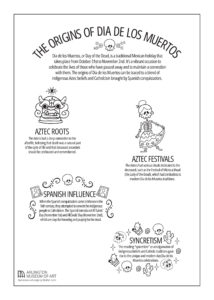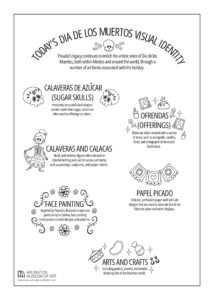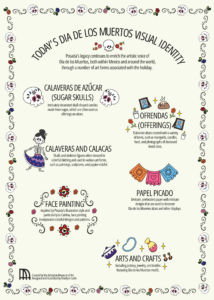The history of Dia de los Muertos in Mexico is rich in cultural heritage and colorful celebrations.
Click on each image below to download three coloring pages that you can customize yourself!
![]()
![]()
![]()
TEXT ONLY VERSION OF THE IMAGES ABOVE
Dia de los Muertos, or Day of the Dead, is a traditional Mexican holiday that takes place from November 1 and 2 (though other days, such as October 31 or November 6, may be included depending on the locality). It’s a vibrant occasion to celebrate the lives of those who have passed away and to maintain a connection with them.
![]()
The Origins of Dia de los Muertos

The origins of Dia de los Muertos can be traced to a blend of indigenous Aztec beliefs and Catholicism brought by Spanish conquistadors.
-
Aztec Roots: The Aztecs had a deep connection to the afterlife, believing that death was a natural part of the cycle of life and that deceased ancestors should be celebrated and remembered.
-
Aztec Festivals: The Aztecs had various rituals dedicated to the deceased, such as the Festival of Mictecacihuatl (the Lady of the Dead), which had similarities to modern Dia de los Muertos traditions.
-
Spanish Influence: When the Spanish conquistadors came to Mexico in the 16th century, they attempted to convert the indigenous people to Catholicism. The Spanish introduced All Saints’ Day (November 1st) and All Souls’ Day (November 2nd), which are days for honoring and praying for the dead.
-
Syncretism: The resulting “syncretism” or amalgamation of indigenous beliefs and Catholic traditions gave rise to the unique and modern-day Dia de los Muertos celebrations.

José Guadalupe Posada and Dia de los Muertos

José Guadalupe Posada (1852-1913) was a Mexican artist and printmaker who had a significant influence on the imagery associated with Dia de los Muertos.
-
Calaveras and Calacas: Posada’s calaveras (skulls) and calacas (skeleton) often carried political and social commentary, highlighting the absurdity and inevitability of death.
-
La Calavera Catrina: Posada’s most famous and influential calavera is La Calavera Catrina, a satirical and elegant character depicted in a fancy hat. La Catrina has become an iconic symbol of Dia de los Muertos, symbolizing the idea that death is an equalizer, affecting people from all social classes.
-
Illustration Style: Posada’s style of illustration, characterized by detailed and intricate linework, made his images visually striking and a popular choice for decorating ofrendas (altars) during Dia de los Muertos.
-
Popularization: Posada’s work, which was widely circulated during his lifetime, resonated with the Mexican people and helped establish a visual vocabulary for Dia de los Muertos.

Today’s Dia de los Muertos Visual Identity

Posada’s legacy continues to enrich the artistic voice of Dia de los Muertos, both within Mexico and around the world, through a number of art forms associated with the holiday.
-
Calaveras de Azúcar (Sugar Skulls): Intricately decorated skull-shaped candies made from sugar, which are often used as offerings on altars.
-
Ofrendas (Offerings): Elaborate altars created with a variety of items, such as marigolds, candles, food, and photographs of deceased loved ones.
-
Calaveras and Calacas: Skulls and skeleton figures often dressed in colorful clothing and used in various art forms, such as paintings, sculptures, and papier-mâché.
-
Papel Picado: Delicate, perforated paper with intricate designs that are used to decorate Dia de los Muertos altars and other displays.
-
Face Painting: Inspired by Posada’s illustration style and particularly La Catrina, face painting incorporates colorful designs and patterns.
-
Art and Crafts: Including pottery, jewelry, and textiles featuring Dia de los Muertos motifs.



